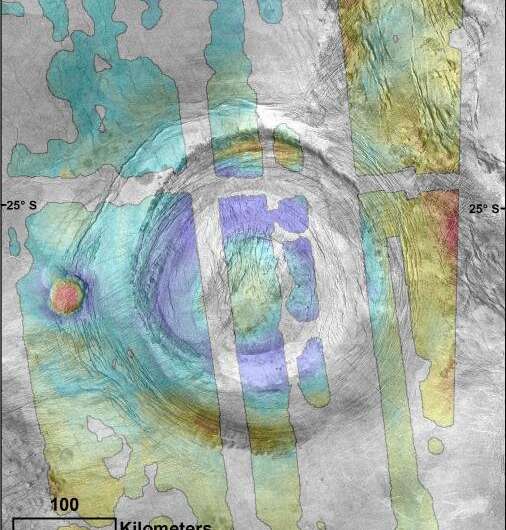New evidence of geologically-recent Venusian volcanism

New data analysis techniques allow evidence of recent volcanism to be found in old Magellan spacecraft data. It is unclear if this activity is occurring today, or if it occurred within tens of million years, but geologically speaking, either case is recent. This adds to the growing body of evidence that volcanoes on Venus didn't go extinct as long ago as many had thought. This work was conducted by Planetary Science Institute (PSI) researchers Megan Russell and Catherine Johnson.
In the 31 years since NASA's Magellan spacecraft entered orbit around Venus, researchers have been using the mission's radar images, topography and gravity mapping to understand the surface history of this cloud-covered world. Early results made it clear that Venus has significantly fewer impact craters on its surface than its cousins Mars and Mercury, and the craters that it does have are randomly scattered across the planet. Craters build up over time, and Venus's low number of craters means it has a surface that was somehow wiped clean roughly 300 million to 1 billion years ago. It is unclear if this was a catastrophic event that resurfaced the entire planet at once, or randomly distributed ongoing events that systematically resurfaced Venus over time, or some combination of both options. To understand what happened, it is necessary to understand when volcanoes have been active.
"The question of whether Venus has had geologically recent or ongoing volcanism has been an enduring enigma from the Magellan mission: we still have no smoking gun regarding this but more and more lines of evidence suggest a recently, and potentially currently, active planet," said PSI Senior Scientist Catherine Johnson.
As computers have improved, it has become possible to do more and more with Magellan's finite data set. Russell and Johnson used a high resolution stereo topography data set generated by other researchers to look at a volcano at the edge of the 350-kilometer across Aramaiti Corona.
Corona are roughly circular features, surrounded by a ring of cracks that appear roughly like a crown, and are thought to be large faults. At some coronae, like Aramaiti, volcanoes and/or lava flows are observed close to or on these fractures. The volcano studied by the PSI researchers was part of the lucky 20% of Venus' surface to be imaged in stereo with synthetic aperture radar (SAR), which revealed the elevations across the 3-D structure, providing a better view than a simple image.
"Instead of looking at the surface of the volcano or flows, we look at how the volcano deforms the ground around it. In response to the weight of the volcano, the ground around it bends, like flexing a plastic ruler," said Megan Russell, a Research Associate at PSI and lead author of Evidence for a Locally Thinned Lithosphere Associated With Recent Volcanism at Aramaiti Corona, Venus that appears in Journal of Geophysical Research Planets. "The same kind of deformation is seen in the bending of the seafloor around the Hawaiian islands. From this deformation, we can infer properties like heat flow local to the volcano.
To go beyond simply indicating younger versus older, it is necessary to use complex computer models to model the surface deformation. It is from this modeled deformation that properties like heat flow can be inferred.
Over time, these kinds of structures can evolve, and the degree of deformation that is observed hints at how old or young a feature might be and how much heat might be flowing under the surface.
Russell goes on to explain, "Modeling studies suggest that the shape and topography of this corona indicate that it is also geologically young, and would have similarly geologically young volcanism associated with it."
This particular structure seems to be unique in Magellan's limited data set. Only seven other coronae in the 20% of Venus that Magellan studied with SAR have steep-sided volcanoes on or near their fractured ring like that studied by Russell and Johnson. In addition, the stereo topography data on the feature in this study was of particularly high quality. With three future missions planned for Venus, this team looks forward to exploring this question in greater detail in the future. "Happily for those of us who were lucky enough to start our careers working on the Magellan mission, there are now three new missions slated to fly to Venus in the next decade or so."
For Johnson, Venus has already played a multi decade role; she worked on her Ph.D. in 1984-1989 with a Guest Investigator on Magellan. For Russell, this work is a great start to her career. This research was performed while Russell was a graduate.
No comments:
Post a Comment